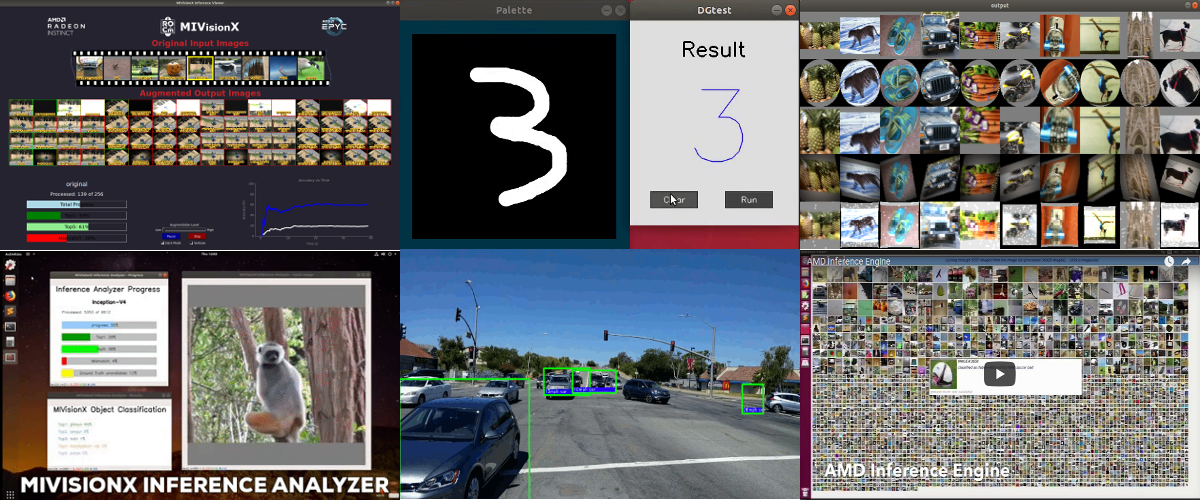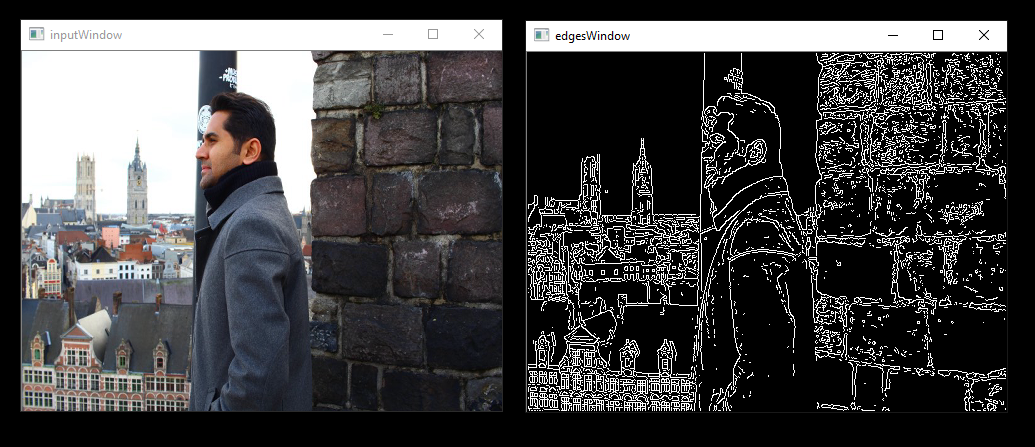MIVisionX toolkit is a set of comprehensive computer vision and machine intelligence libraries, utilities, and applications bundled into a single toolkit. AMD MIVisionX delivers highly optimized conformant open-source implementation of the Khronos OpenVX™ and OpenVX™ Extensions along with Convolution Neural Net Model Compiler & Optimizer supporting ONNX, and Khronos NNEF™ exchange formats. The toolkit allows for rapid prototyping and deployment of optimized computer vision and machine learning inference workloads on a wide range of computer hardware, including small embedded x86 CPUs, APUs, discrete GPUs, and heterogeneous servers.
- Table of Contents
- AMD OpenVX™
- AMD OpenVX™ Extensions
- Applications
- Neural Net Model Compiler & Optimizer
- rocAL
- Toolkit
- Utilities
- Prerequisites
- Build & Install MIVisionX
- Verify the Installation
- Docker
- Technical Support
- Release Notes
- MIVisionX Dependency Map
AMD OpenVX™ is a highly optimized conformant open source implementation of the Khronos OpenVX™ 1.3 computer vision specification. It allows for rapid prototyping as well as fast execution on a wide range of computer hardware, including small embedded x86 CPUs and large workstation discrete GPUs.
Khronos OpenVX™ 1.0.1 conformant implementation is available in MIVisionX Lite
The OpenVX framework provides a mechanism to add new vision functionality to OpenVX by vendors. This project has below mentioned OpenVX modules and utilities to extend amd_openvx, which contains the AMD OpenVX™ Core Engine.
- amd_loomsl: AMD Radeon Loom stitching library for live 360 degree video applications
- amd_media:
vx_amd_mediais an OpenVX AMD media extension module for encode and decode - amd_migraphx: amd_migraphx extension integrates the AMD's MIGraphx into an OpenVX graph. This extension allows developers to combine the vision funcions in OpenVX with the MIGraphX and build an end-to-end application for inference.
- amd_nn: OpenVX neural network module
- amd_opencv: OpenVX module that implements a mechanism to access OpenCV functionality as OpenVX kernels
- amd_rpp: OpenVX extension providing an interface to some of the RPP's (Radeon Performance Primitives) functions. This extension is used to enable rocAL to perform image augmentation.
- amd_winml: WinML extension will allow developers to import a pre-trained ONNX model into an OpenVX graph and add hundreds of different pre & post processing
vision/generic/user-definedfunctions, available in OpenVX and OpenCV interop, to the input and output of the neural net model. This will allow developers to build an end to end application for inference.
MIVisionX has several applications built on top of OpenVX modules, it uses AMD optimized libraries to build applications that can be used to prototype or use as a model to develop products.
- Bubble Pop: This sample application creates bubbles and donuts to pop using OpenVX & OpenCV functionality.
- Cloud Inference Application: This sample application does inference using a client-server system.
- Digit Test: This sample application is used to recognize hand written digits.
- Image Augmentation: This sample application demonstrates the basic usage of rocAL's C API to load JPEG images from the disk and modify them in different possible ways and displays the output images.
- MIVisionX Inference Analyzer: This sample application uses pre-trained
ONNX/NNEF/Caffemodels to analyze and summarize images. - MIVisionX OpenVX Classsification: This sample application shows how to run supported pre-trained caffe models with MIVisionX RunTime.
- MIVisionX Validation Tool: This sample application uses pre-trained
ONNX/NNEF/Caffemodels to analyze, summarize and validate models. - MIVisionX WinML Classification: This sample application shows how to run supported ONNX models with MIVisionX RunTime on Windows.
- MIVisionX WinML YoloV2: This sample application shows how to run tiny yolov2(20 classes) with MIVisionX RunTime on Windows.
- Optical Flow: This sample application creates an OpenVX graph to run Optical Flow on a video/live.
- External Applications
Neural Net Model Compiler & Optimizer converts pre-trained neural net models to MIVisionX runtime code for optimized inference.
The ROCm Augmentation Library - rocAL is designed to efficiently decode and process images and videos from a variety of storage formats and modify them through a processing graph programmable by the user.
MIVisionX Toolkit, is a comprehensive set of helpful tools for neural net creation, development, training, and deployment. The Toolkit provides you with helpful tools to design, develop, quantize, prune, retrain, and infer your neural network work in any framework. The Toolkit is designed to help you deploy your work to any AMD or 3rd party hardware, from embedded to servers.
MIVisionX provides you with tools for accomplishing your tasks throughout the whole neural net life-cycle, from creating a model to deploying them for your target platforms.
- inference_generator: generate inference library from pre-trained CAFFE models
- loom_shell: an interpreter to prototype 360 degree video stitching applications using a script
- RunVX: command-line utility to execute OpenVX graph described in GDF text file
- RunCL: command-line utility to build, execute, and debug OpenCL programs
-
CPU: AMD64
-
GPU: AMD Radeon™ Graphics [optional]
-
APU: AMD Radeon™
Mobile/Embedded[optional]Note: Some modules in MIVisionX can be built for
CPU ONLY. To take advantage ofAdvanced Features And Moduleswe recommend usingAMD GPUsorAMD APUs.
- Windows
10/11 - Windows SDK
- Visual Studio 2019 or later
- Install the latest AMD drivers
- Install OpenCL SDK
- Install OpenCV 4.6.0
- Set
OpenCV_DIRenvironment variable toOpenCV/buildfolder - Add
%OpenCV_DIR%\x64\vc14\binor%OpenCV_DIR%\x64\vc15\binto yourPATH
- Set
-
Install Homebrew
-
Install CMake
-
Install OpenCV
3/4Note: macOS build instructions
- Linux distribution
- Ubuntu -
20.04/22.04 - CentOS -
7/8 - RedHat -
8/9 - SLES -
15-SP3
- Ubuntu -
- Install ROCm
- CMake 3.0 or later
- ROCm MIOpen for
Neural Net Extensions(vx_nn) - Qt Creator for Cloud Inference Client
- Protobuf for inference generator & model compiler
- install
libprotobuf-devandprotobuf-compilerneeded for vx_nn
- install
- OpenCV 4.6.0
- Set
OpenCV_DIRenvironment variable toOpenCV/buildfolder
- Set
- FFMPEG n4.4.2
- FFMPEG is required for amd_media & mv_deploy modules
- rocAL Prerequisites
For the convenience of the developer, we here provide the setup script which will install all the dependencies required by this project.
NOTE: This script only needs to be executed once.
-
Linux distribution
- Ubuntu -
20.04/22.04 - CentOS -
7/8 - RedHat -
8/9 - SLES -
15-SP3
- Ubuntu -
-
usage:
python MIVisionX-setup.py --directory [setup directory - optional (default:~/)] --opencv [OpenCV Version - optional (default:4.6.0)] --protobuf [ProtoBuf Version - optional (default:3.12.4)] --rpp [RPP Version - optional (default:0.99)] --ffmpeg [FFMPEG V4.4.2 Installation - optional (default:ON) [options:ON/OFF]] --rocal [MIVisionX rocAL Dependency Install - optional (default:ON) [options:ON/OFF]] --neural_net[MIVisionX Neural Net Dependency Install - optional (default:ON) [options:ON/OFF]] --inference [MIVisionX Neural Net Inference Dependency Install - optional (default:ON) [options:ON/OFF]] --reinstall [Remove previous setup and reinstall (default:OFF)[options:ON/OFF]] --backend [MIVisionX Dependency Backend - optional (default:HIP) [options:HIP/OCL/CPU]] --rocm_path [ROCm Installation Path - optional (default:/opt/rocm) - ROCm Installation Required]Note:
- ROCm upgrade with
sudo apt upgraderequires the setup script rerun. - use
X Window/X11for remote GUI app control
- ROCm upgrade with
- MIVisionX-installer.msi: MIVisionX
- MIVisionX_WinML-installer.msi: MIVisionX for WinML
-
Install Windows Prerequisites
-
Use
MIVisionX.slnto build for x64 platformNOTE:
vx_nnis not supported onWindowsin this release
macOS build instructions
-
Install ROCm
-
On
Ubuntusudo apt-get install mivisionx -
On
CentOSsudo yum install mivisionxNote:
vx_winmlis not supported onLinux- source code will not available with
apt-get/yuminstall - the installer will copy
- Executables into
/opt/rocm/bin - Libraries into
/opt/rocm/lib - OpenVX and module header files into
/opt/rocm/include/mivisionx - Model compiler, & toolkit folders into
/opt/rocm/libexec/mivisionx - Apps, & samples folder into
/opt/rocm/share/mivisionx - Docs folder into
/opt/rocm/share/doc/mivisionx
- Executables into
- Package (.deb & .rpm) install requires
OpenCV v3+to executeAMD OpenCV extensions
-
Install ROCm
-
Use the below commands to set up and build MIVisionX
git clone https://github.com/GPUOpen-ProfessionalCompute-Libraries/MIVisionX.git cd MIVisionXNote: MIVisionX has support for two GPU backends: OPENCL and HIP:
-
Instructions for building MIVisionX with the HIP GPU backend (i.e., default GPU backend):
- run the setup script to install all the dependencies required by the HIP GPU backend:
python MIVisionX-setup.py- run the below commands to build MIVisionX with the HIP GPU backend:
mkdir build-hip cd build-hip cmake ../ make -j8 sudo make install -
Instructions for building MIVisionX with OPENCL GPU backend:
- run the setup script to install all the dependencies required by the OPENCL GPU backend:
python MIVisionX-setup.py --reinstall ON --backend OCL- run the below commands to build MIVisionX with the OPENCL GPU backend:
mkdir build-ocl cd build-ocl cmake -DBACKEND=OPENCL ../ make -j8 sudo make install
Note:
- MIVisionX cannot be installed for both GPU backends in the same default folder (i.e., /opt/rocm/) if an app interested in installing MIVisionX with both GPU backends, then add -DCMAKE_INSTALL_PREFIX in the cmake commands to install MIVisionX with OPENCL and HIP backends into two separate custom folders.
- vx_winml is not supported on Linux
-
-
The installer will copy
- Executables into
/opt/rocm/bin - Libraries into
/opt/rocm/lib - OpenVX and OpenVX module header files into
/opt/rocm/include/mivisionx - Apps, & Samples folder into
/opt/rocm/share/mivisionx - Documents folder into
/opt/rocm/share/doc/mivisionx - Model Compiler, and Toolkit folder into
/opt/rocm/libexec/mivisionx
- Executables into
-
Run the below sample to verify the installation
Canny Edge Detection
export PATH=$PATH:/opt/rocm/bin export LD_LIBRARY_PATH=$LD_LIBRARY_PATH:/opt/rocm/lib runvx /opt/rocm/share/mivisionx/samples/gdf/canny.gdfNote: More samples are available here
Note: For
macOSuseexport DYLD_LIBRARY_PATH=$DYLD_LIBRARY_PATH:/opt/rocm/lib
-
MIVisionX.sln builds the libraries & executables in the folder
MIVisionX/x64 -
Use RunVX to test the build
./runvx.exe PATH_TO/MIVisionX/samples/gdf/skintonedetect.gdf
MIVisionX provides developers with docker images for Ubuntu 20.04 and CentOS 7 / 8. Using docker images developers can quickly prototype and build applications without having to be locked into a single system setup or lose valuable time figuring out the dependencies of the underlying software.
Docker files to build MIVisionX containers are available
- Ubuntu
20.04/22.04 - rocm supported hardware
- Step 1 - Install rocm-dkms
sudo apt update -y
sudo apt dist-upgrade -y
sudo apt install libnuma-dev wget
sudo reboot
wget https://repo.radeon.com/amdgpu-install/21.50/ubuntu/focal/amdgpu-install_21.50.50000-1_all.deb
sudo apt-get install -y ./amdgpu-install_21.50.50000-1_all.deb
sudo apt-get update -y
sudo amdgpu-install -y --usecase=rocm
sudo reboot
- Step 2 - Setup Docker
sudo apt-get install curl
sudo curl -fsSL https://download.docker.com/linux/ubuntu/gpg | sudo apt-key add -
sudo add-apt-repository "deb [arch=amd64] https://download.docker.com/linux/ubuntu $(lsb_release -cs) stable"
sudo apt-get update
apt-cache policy docker-ce
sudo apt-get install -y docker-ce
sudo systemctl status docker
- Step 3 - Get Docker Image
sudo docker pull mivisionx/ubuntu-20.04
- Step 4 - Run the docker image
sudo docker run -it --device=/dev/kfd --device=/dev/dri --cap-add=SYS_RAWIO --device=/dev/mem --group-add video --network host mivisionx/ubuntu-20.04:latest
Note:
-
Map host directory on the docker image
- map the localhost directory to be accessed on the docker image.
- use
-voption with docker run command:-v {LOCAL_HOST_DIRECTORY_PATH}:{DOCKER_DIRECTORY_PATH} - usage:
sudo docker run -it -v /home/:/root/hostDrive/ --device=/dev/kfd --device=/dev/dri --cap-add=SYS_RAWIO --device=/dev/mem --group-add video --network host mivisionx/ubuntu-20.04:latest -
Display option with docker
- Using host display
xhost +local:root sudo docker run -it --device=/dev/kfd --device=/dev/dri --cap-add=SYS_RAWIO --device=/dev/mem --group-add video --network host --env DISPLAY=unix$DISPLAY --privileged --volume $XAUTH:/root/.Xauthority --volume /tmp/.X11-unix/:/tmp/.X11-unix mivisionx/ubuntu-20.04:latest- Test display with MIVisionX sample
export PATH=$PATH:/opt/rocm/bin export LD_LIBRARY_PATH=$LD_LIBRARY_PATH:/opt/rocm/lib runvx /opt/rocm/share/mivisionx/samples/gdf/canny.gdf
Please email mivisionx.support@amd.com for questions, and feedback on MIVisionX.
Please submit your feature requests, and bug reports on the GitHub issues page.
Review all notable changes with the latest release
- Windows
10/11 - Linux distribution
- Ubuntu -
20.04/22.04 - CentOS -
7/8 - RedHat -
8/9 - SLES -
15-SP3
- Ubuntu -
- ROCm: rocm-core -
5.4.0.50400-72 - miopen-hip -
2.19.0.50400-72 - miopen-opencl -
2.18.0.50300-63 - migraphx -
2.4.0.50400-72 - Protobuf - V3.12.4
- OpenCV - 4.6.0
- RPP - 0.99
- FFMPEG - n4.4.2
- Dependencies for all the above packages
- MIVisionX Setup Script -
V2.4.0
- Package install requires OpenCV
V-4.6.Xto executeAMD OpenCV extensions
Docker Image: sudo docker build -f docker/ubuntu20/{DOCKER_LEVEL_FILE_NAME}.dockerfile -t {mivisionx-level-NUMBER} .
NOTE: OpenVX and the OpenVX logo are trademarks of the Khronos Group Inc.















